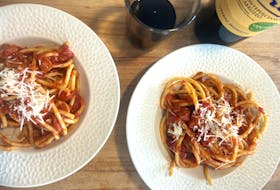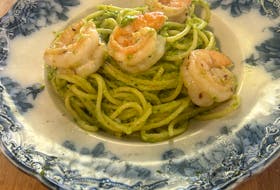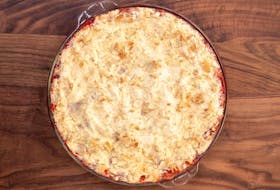I have to admit that I’m not the world’s biggest fan of rutabaga. Its assertive, sweet-bitter taste has not always been agreeable to my palate, thus I can count how many times I’ve cooked this often overlooked vegetable on both hands.
But, all it takes is one recipe to turn things around, and this pretty purée is it. I’ve discovered that by combining rutabaga with another vegetable I quite like, the intensity of the ‘baga is substantially decreased, plus butter and cream are always helpful when it comes to adding flavour. Yay for fat!
Rutabaga (sometimes called Swede) is a root vegetable that is a cross between cabbage and turnips. A member of the brassica family, rutabaga is known by many other names throughout the world, including yellow turnip, Swedish turnip, or neeps. There can be some confusion between a rutabaga and a turnip. Turnips are usually white and purple on the outside, with very white flesh, while the skin of the rutabaga is creamy yellow flushed with deep purple. Rutabaga boasts a warm, yellow flesh that becomes more saturated upon cooking. While some vegetables will lose a little of their colour when boiled, the rutabaga deepens to a translucent yellow orange. Of course with the addition of carrots to this purée, the colour is that of a shimmering winter sunset. Rutabagas are also generally much larger than turnips.
So for a rule of thumb, the deep purple yellowish veg are rutabagas, and the smaller, white and purple ones are turnips. In terms of flavour, rutabagas taste sweet with a bitter afternote, whereas turnips have a slight radish flavour. The biggest difference between the two root vegetables is their size. Turnips are best when small and tender, no bigger than the size of a tennis ball. Any larger and they’ll be woody as all heck. Rutabagas stay tender at larger sizes, and even though you might find some small ones, they are usually harvested at the size of a grapefruit. Their skin is often coated with a food-grade wax that helps extend its shelf life, thus it is a good idea to peel them before cooking.
A rutabaga is meant to be eaten when there’s snow on the ground and frost is blooming on windows. It likes to soak up flavours it’s married to, so adding chunks to hearty stews and pot pies is a good place to start if you aren’t super keen on eating rutabaga on its own. I like to use less rutabaga compared to other vegetables just so its intense flavour doesn’t dominate the pot.
The fact that rutabaga is a member of the cabbage family means it goes rather well with bacon, apples, mustard, garlic, rosemary, and dill. It likes to associate with parsnips, sweet potatoes, carrots, onions, and potatoes. Any of these would make a great mash for a side dish — don’t be shy with the butter and cream. Rutabaga is a wonderful accompaniment to roast meat, particularly pork, beef, lamb, and game. Tuck nuggets in while roasting, or nestle a purée alongside.
You can use rutabaga in most recipes that call for turnips or even carrots. Grate, julienne, or thinly slice them into slaws and salads. Roast them with olive oil and salt until crispy. Cut them into cubes, toss in some herbs, thin slices of onion, and a few good knobs of butter. Cover with foil and bake until tender. Add thin strips of rutabaga to your favourite stir-fry or sheet pan supper. Rutabaga mash is less starchy than mashed potatoes but they can be seasoned in much the same way. Add butter, garlic, and a splash of cream or even a little bit of cream cheese.
This creamy rutabaga and carrot purée came together rather quickly, and if you don’t have broth, just use water. No food processor? No problem. Just use a potato masher, though the texture won’t be quite as smooth. This is a dish that has changed my rutabaga-avoidance tendencies, and I couldn’t be happier. I guess it’s never too late for a food writer to learn new tricks!
Rutabaga and Carrot Purée
2 medium rutabaga (2 lb. total) peeled and cut into 1-inch pieces
4 medium carrots, peeled and cut into 1-inch pieces
1 cup chicken or vegetable broth
2 Tbsp salted butter
2 Tbsp whipping cream
1 Tbsp maple syrup
1/2 tsp. salt
1/4 tsp. pepper
small pinch of nutmeg
1. Place the vegetables in a medium saucepan. Pour in the broth. Cover the rest with water. Bring to a boil over high heat. Cover, turn the heat down to low and simmer for 30 minutes, or until the vegetables are fork-tender.
2. Drain, then place them in the bowl of a food processor fitted with a metal blade. Add the butter, cream, maple syrup, salt, pepper, and nutmeg. Purée until very smooth. Season to taste. If necessary, place the purée back in the pot to reheat. Makes 4-6 servings.
Related
The news seems to be flying at us faster all the time. From COVID-19 updates to politics and crime and everything in between, it can be hard to keep up. With that in mind, the Saskatoon StarPhoenix has created an Afternoon Headlines newsletter that can be delivered daily to your inbox to help make sure you are up to date with the most vital news of the day. Click here to subscribe.
Copyright Postmedia Network Inc., 2021








